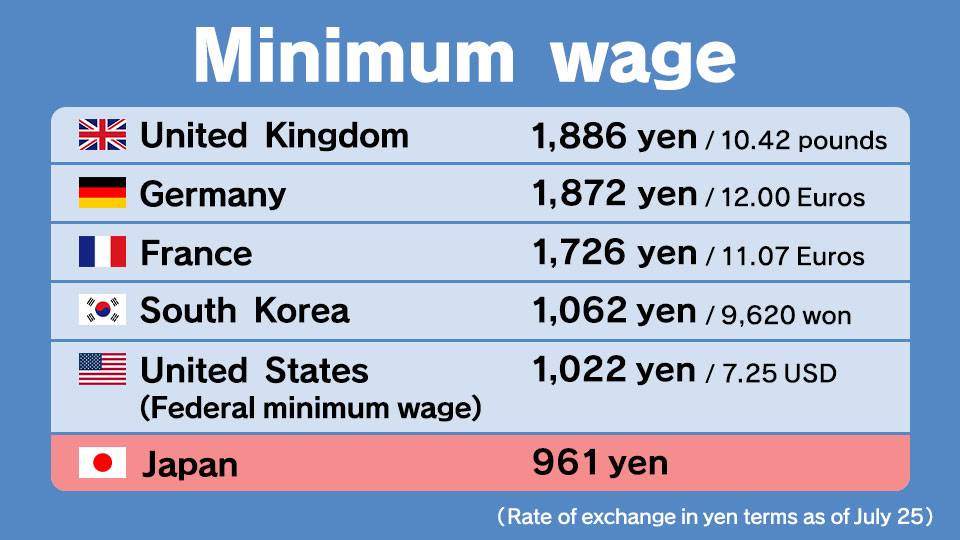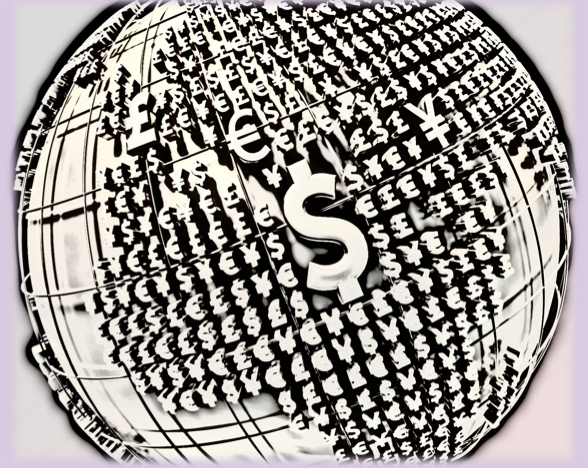Japan minimum wage surged by 5% in 2024, the largest increase in history, reaching 1,055 yen per hour. With plans to hit 1,500 yen by 2029, how will this impact workers, SMEs, and global competitiveness?

Japan’s economy has shown resilience and moderate growth in recent years, supported by strong private consumption and business investment. In the fourth quarter of 2024, the country’s Gross Domestic Product (GDP) expanded at an annualised rate of 2.8%, exceeding expectations and marking the third consecutive quarter of growth. This performance was largely driven by increased business spending and an unexpected rise in private consumption.
For the whole of 2024, Japan’s GDP grew by 0.1%, continuing a four-year expansion trend. Notably, nominal GDP reached a record $4 trillion, surpassing $3.9 trillion for the first time.
In terms of trade, Japan recorded a trade deficit of $18 billion in January 2025, as both exports and imports saw significant growth. Exports increased by 7% year-on-year, reaching $52 billion, driven by products such as machinery, medical goods, and ships. Imports rose by 16.7%, totalling $70 billion, mainly due to demand for machinery, computers, and foodstuffs.
Regarding wages, Japan introduced a notable increase in the national average minimum wage for the 2024 fiscal year, raising it by ¥51 to an hourly rate of ¥1,055. This 5.1% rise reflects government efforts to boost consumer spending and address inflationary pressures. Regionally, Tokyo’s minimum wage was set at ¥1,163 per hour, Kanagawa at ¥1,162, and Osaka at ¥1,114, all exceeding the ¥1,100 mark. However, disparities remain, with 12 prefectures, particularly in the Tōhoku, Kyūshū/Okinawa, and Shikoku regions, maintaining minimum wages below ¥950 per hour.
We did an article on global wage disparities and the factors influencing them in our latest article, “The Reality About World Salaries.” Gain insights into how economic shifts, technological advancements, and demographic changes are reshaping salary structures worldwide. Read the full article here.
This article provides a detailed analysis of Japan’s minimum wage system, recent developments, comparisons with other nations, and the potential future trajectory of wage policies in the country.
Japan Minimum Wage System: A closer look
The foundation of Japan’s minimum wage system was established in 1968 through revisions to the Minimum Wage Act. The system operates on two key pillars: the council method and the collective agreement extension method. Despite this framework, the system faced challenges in aligning wage levels with the actual economic realities of workers until 2007. That year, a significant revision shifted the focus to prefecture-specific minimum wages, allowing for more responsive and context-sensitive adjustments.
The system operates under two main categories:
- Regional Minimum Wage – Determined at the prefectural level, considering local economic conditions and industry needs.
- Industrial Minimum Wage – Set for specific industries that require a higher wage due to the nature of work or economic impact.
Each prefecture in Japan establishes its minimum wage based on recommendations from local wage councils. These councils assess regional economic conditions, business sustainability, and cost-of-living considerations before determining the wage level.
Despite government efforts, the gap between the lowest and highest minimum wages across Japan remains significant. Tokyo, as the economic hub, has the highest minimum wage, while rural prefectures maintain lower rates due to their economic structure.
Recent increase in Japan’s minimum wage
In July 2024, the Japanese Labor Ministry announced a landmark decision to raise the national average minimum wage to 1,055 yen per hour, marking a 5% increase. This adjustment, the largest in the country’s history, was implemented in October 2024. The decision was driven by the need to counteract the effects of global inflation, which had outpaced wage growth for 26 consecutive months. Additionally, the depreciation of the yen had placed significant strain on Japan’s international trade sector, reducing purchasing power for imported goods.
Key figures of the 2024 wage increase
- Tokyo: Increased from 1,113 yen to 1,163 yen per hour.
- Osaka, Kyoto, and Kanagawa: Now exceed 1,000 yen per hour.
- Lowest Prefecture Wage (Iwate): Previously 893 yen per hour, now surpasses 950 yen.
The wage increase was a response to rising inflation, the depreciation of the yen, and concerns about the purchasing power of workers. However, it also placed pressure on small and medium-sized enterprises (SMEs), which struggle to keep up with labour cost increases.
Current minimum wage levels in Japan
As of October 2024, Japan’s minimum wage varies by prefecture, with each region setting its own rate based on economic conditions and industry-specific considerations. The national average has risen from 1,004 yen to 1,055 yen per hour. Tokyo, as the country’s economic hub, boasts the highest minimum wage at 1,163 yen per hour, while Iwate Prefecture has the lowest at 893 yen per hour. Most urban areas, including Osaka, Kyoto, and Kanagawa, exceed the 1,000 yen mark, with all prefectures now surpassing 950 yen per hour.
This regional variation underscores the importance of localised wage policies, ensuring that minimum wage levels reflect the cost of living and economic activity in each area.
Comparison with other countries
While Japan’s recent wage hike is a step forward, its minimum wage still lags behind other developed economies.
Japan minimum wage vs other nations (Hourly Rates in USD)
| Country | Hourly Minimum Wage (USD) |
| Japan (Tokyo) | 7.60 USD |
| United States (Federal) | 7.25 USD |
| New York, USA | 16.00 USD |
| Australia | 15.70 USD |
| Germany | 13.61 USD |
| Netherlands | 14.38 USD |
Japan’s highest minimum wage (Tokyo) is only slightly above the United States’ national minimum but significantly lower than places like New York, Australia, and several European nations. This indicates that despite being one of the world’s largest economies, Japan has room for improvement in labour wages.
Economic impact and business challenges
The 5% wage increase in 2024 aimed to boost consumer spending and improve living standards. However, it also posed significant challenges, particularly for small businesses. The Japanese government has recognised these challenges and plans to introduce business support measures to offset the impact of higher wages.
- SME struggles: Approximately 70% of small businesses reported financial strain due to increased labour costs.
- Import costs and inflation: A weaker yen has made imported goods more expensive, reducing the real impact of wage hikes.
- Employment shifts: Some businesses have reduced hiring or automated processes to counterbalance higher wages.
The future of Japan’s minimum wage
The recent 50 yen increase in the minimum wage is part of a broader, long-term strategy to enhance workers’ earnings. In 2023, under Prime Minister Kishida’s administration, the government announced plans to raise the average minimum wage to 1,500 yen per hour by the mid-2030s. This ambitious target reflects a commitment to improving living standards and addressing income inequality.
More recently, Japan’s newly appointed Prime Minister Ishiba has proposed accelerating this timeline, aiming to achieve the 1,500 yen goal by the end of 2029. While this plan has been met with optimism, concerns remain about its feasibility, particularly for small businesses. The Tokyo Chamber of Commerce reported that nearly 70% of companies felt the current minimum wage levels were negatively impacting their operations.
To mitigate these challenges, the government has pledged to support small businesses through cost-saving measures and regulatory improvements. Chief Cabinet Secretary Hasahi emphasised the administration’s commitment to ensuring that wage increases do not come at the expense of local enterprises. However, the long-term implications of these policies remain uncertain, particularly as businesses adapt to the evolving economic landscape.
Final thoughts
The increase in Japan’s minimum wage is a significant step toward improving workers’ earnings and aligning with global wage standards. However, the country still lags behind other developed economies, and further increases are necessary to enhance Japan’s attractiveness as a destination for skilled workers.
While the government has set ambitious targets, the path to achieving a 1,500 yen per hour wage by 2029 or 2035 will depend on several economic factors, including business adaptability, inflation rates, and overall economic growth.
For foreign professionals considering work opportunities in Japan, wage figures should be analysed beyond national averages. Skilled workers, particularly in technology and specialised industries, often receive higher-than-minimum wages, making Japan a competitive option for career development.
As Japan navigates this economic transition, workers, businesses, and policymakers will need to find a balanced approach to ensure sustainable wage growth while maintaining Japan’s competitive business environment.

Pallavi Singal is the Vice President of Content at ztudium, where she leads innovative content strategies and oversees the development of high-impact editorial initiatives. With a strong background in digital media and a passion for storytelling, Pallavi plays a pivotal role in scaling the content operations for ztudium’s platforms, including Businessabc, Citiesabc, and IntelligentHQ, Wisdomia.ai, MStores, and many others. Her expertise spans content creation, SEO, and digital marketing, driving engagement and growth across multiple channels. Pallavi’s work is characterised by a keen insight into emerging trends in business, technologies like AI, blockchain, metaverse and others, and society, making her a trusted voice in the industry.

































